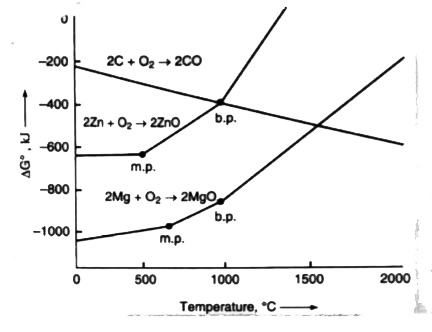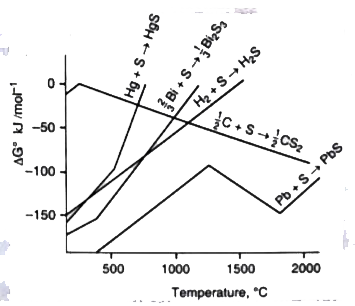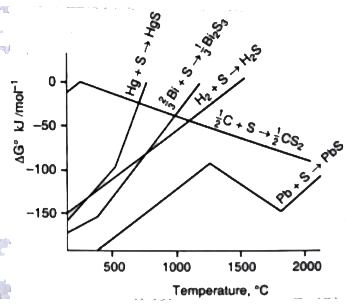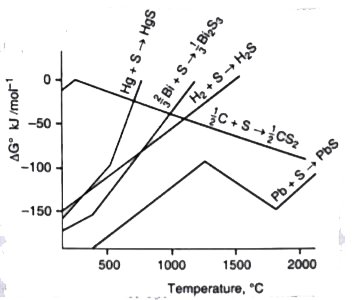Level 3 (Passive 5) from VK JAISWAL CHEMISTRY (HINGLISH) METALLURGY for Class 12
| Class 12 | CHEMISTRY |
| Chapter | METALLURGY |
| VK JAISWAL CHEMISTRY (HINGLISH) | Level 3 (Passive 5) |
| Medium | English |
| Academic Year | 2023-2024 |
Question 1
For a sponaneous reaction, the free energy change must be negative, ΔG=ΔH−TΔS,ΔH is the enthalpy change during the reaction. T is the absolute temperature, and ΔS is the change in entropy during the reaction. Consider a reaction such as the formation of an oxide
M+O2→MO
Dioxygen is used up in the course of this reaction. Gases have a more random structure (less ordered) than liquid or solids. Consequently gases have a higher entropy than liquids and solids. In this reaction S (entropy or randomness) decreases, hence ΔS is negative. Thus, if the temperature is raised then TΔS becomes more negative,Since, TΔS is substracted in the equation, then ΔG becomes less negative. Thus, the free energy change increases with the increase in temperature.
The free energy changes that occur when one mole of common reactant (in this case dioxygen) is used may be plotted graphically aginst temperature for a number of reactions of metals to their oxides. The following plot is called an Ellingham diagram for metal oxide. Understanding of Ellingham diagram is extremely important for the efficient extraction of metals.
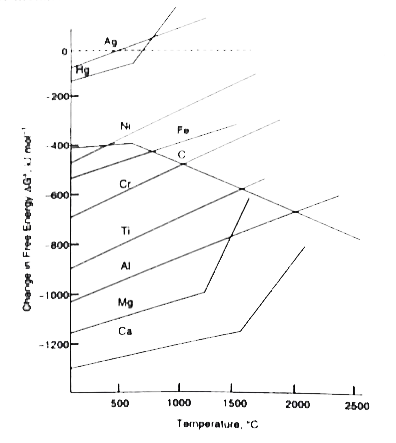
For the conversion of Ca(s) to Ca(s) which of the following represent the ΔG vs. T ?View SolutionQuestion 7
Magnesium is a valuable, light weight metal used as a structural material as well as in alloys, batteries, and in chemical synthesis. Although magnesium is plentiful in Earth's crust, it is mainly found in the sea water (after sodium). There is about 1.3 g of magnesium in every kilogram of sea water. The process for obtaining magnesium from sea water employs all three types of reactions, i.e., precipitation, acid-base, and redox-reactions.
Precipitation reaction involves formation of : View SolutionQuestion 8
Magnesium is a valuable, light weight metal used as a structural material as well as in alloys, batteries, and in chemical synthesis. Although magnesium is plentiful in Earth's crust, it is mainly found in the sea water (after sodium). There is about 1.3 g of magnesium in every kilogram of sea water. The process for obtaining magnesium from sea water employs all three types of reactions, i.e., precipitation, acid-base, and redox-reactions.
Acid-base reaction involves reaction between :View SolutionQuestion 9
Magnesium is a valuable, light weight metal used as a structural material as well as in alloys, batteries, and in chemical synthesis. Although magnesium is plentiful in Earth's crust, it is mainly found in the sea water (after sodium). There is about 1.3 g of magnesium in every kilogram of sea water. The process for obtaining magnesium from sea water employs all three types of reactions, i.e., precipitation, acid-base, and redox-reactions.
Redox reaction takes place (in the extraction of Mg) : View SolutionQuestion 10
Dow's process of extraction of Mg involves extraction of Mg from sea water. Sea water is concentrated in sun-light and is then treated with slaked lime. Magnesium hydroxide is heated in a stream of HCl to give MgCl2 which is electrolysed to discharge Mg. The mixture is in the ratio 35% MgCl2+50%NaCl+15%CaCl2. NaCl and CaCl2 are added to lower the fusion temperature and to increases the conductance.
Mg2++Ca(OH)2→Mg(OH)2+Ca2+
Mg(OH)2+2HCl→MgCl2+2H2O(l)
Electrolysis of fused MgCl2⇔Mg2++2Cl
Mg2++2e−→Mg( At Cathode)
2Cl−→Cl2+2e− (At Anode)
Mg electrolysed is protected from atmospheric oxidation by a blanket of inert gases.
In the hydrated chloride of Mg the value of x is :View SolutionQuestion 11
Dow's process of extraction of Mg involves extraction of Mg from sea water. Sea water is concentrated in sun-light and is then treated with slaked lime. Magnesium hydroxide is heated in a stream of HCl to give MgCl2 which is electrolysed to discharge Mg. The mixture is in the ratio 35% MgCl2+50%NaCl+15%CaCl2. NaCl and CaCl2 are added to lower the fusion temperature and to increases the conductance.
Mg2++Ca(OH)2→Mg(OH)2+Ca2+
Mg(OH)2+2HCl→MgCl2+2H2O(l)
Electrolysis of fused MgCl2⇔Mg2++2Cl
Mg2++2e−→Mg( At Cathode)
2Cl−→Cl2+2e− (At Anode)
Mg electrolysed is protected from atmospheric oxidation by a blanket of inert gases.
Molten mixture contains Mg2+,Na+andCa2+ but at cathode only Mg2+ is discharged because :View SolutionQuestion 12
Dow's process of extraction of Mg involves extraction of Mg from sea water. Sea water is concentrated in sun-light and is then treated with slaked lime. Magnesium hydroxide is heated in a stream of HCl to give MgCl2 which is electrolysed to discharge Mg. The mixture is in the ratio 35% MgCl2+50%NaCl+15%CaCl2. NaCl and CaCl2 are added to lower the fusion temperature and to increases the conductance.
Mg2++Ca(OH)2→Mg(OH)2+Ca2+
Mg(OH)2+2HCl→MgCl2+2H2O(l)
Electrolysis of fused MgCl2⇔Mg2++2Cl
Mg2++2e−→Mg( At Cathode)
2Cl−→Cl2+2e− (At Anode)
Mg electrolysed is protected from atmospheric oxidation by a blanket of inert gases.
Molten mixutre of NaCl and CaCl2 is added to the heated MgCl2 because :View SolutionQuestion 16
Electrolysis is an important technique for extraction of metals, and each ion of the solution needs a minimum voltage to get discharged and this value is expressed in terms of discharge potential. For some metal ions the discharge potentials follow the order given below :
Li+>K+>Ca2+>Na+>Mg2+>Al3+>Zn2+>Fe2+>Ni2+>H3O+>Cu2+>Hg2+2>Ag+>Au3+
For some anions the discharge potentials are in the order :
SO2−4>NO−3>OH−>Br−>I−
When aqueous solution of cupric bromide is electrolyzed the product obtained at cathode will be :View SolutionQuestion 17
Electrolysis is an important technique for extraction of metals, and each ion of the solution needs a minimum voltage to get discharged and this value is expressed in terms of discharge potential. For some metal ions the discharge potentials follow the order given below :
Li+>K+>Ca2+>Na+>Mg2+>Al3+>Zn2+>Fe2+>Ni2+>H3O+>Cu2+>Hg2+2>Ag+>Au3+
For some anions the discharge potentials are in the order :
SO2−4>NO−3>OH−>Br−>I−
The product formed at anode and cathode, when dilute H2SO4 is electrolysed are :View SolutionQuestion 18
Electrolysis is an important technique for extraction of metals, and each ion of the solution needs a minimum voltage to get discharged and this value is expressed in terms of discharge potential. For some metal ions the discharge potentials follow the order given below :
Li+>K+>Ca2+>Na+>Mg2+>Al3+>Zn2+>Fe2+>Ni2+>H3O+>Cu2+>Hg2+2>Ag+>Au3+
For some anions the discharge potentials are in the order :
SO2−4>NO−3>OH−>Br−>I−
A mixture containing chlorides of sodium, calcium and zinc is electrolysed in presence f wate. The product obtained at cathode will be :View SolutionQuestion 19
Electrolysis is an important technique for extraction of metals, and each ion of the solution needs a minimum voltage to get discharged and this value is expressed in terms of discharge potential. For some metal ions the discharge potentials follow the order given below :
Li+>K+>Ca2+>Na+>Mg2+>Al3+>Zn2+>Fe2+>Ni2+>H3O+>Cu2+>Hg2+2>Ag+>Au3+
For some anions the discharge potentials are in the order :
SO2−4>NO−3>OH−>Br−>I−
When conc. H2SO4 is electrolysed with high current using Pt electrodes, the product obtained at anode is :View Solution


